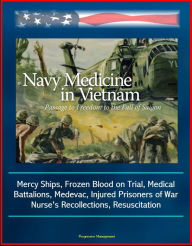Navy Medicine in Vietnam: Passage to Freedom to the Fall of Saigon - Mercy Ships, Frozen Blood on Trial, Medical Battalions, Medevac, Injured Prisoner
by Progressive Management
2021-04-11 16:09:50
Navy Medicine in Vietnam: Passage to Freedom to the Fall of Saigon - Mercy Ships, Frozen Blood on Trial, Medical Battalions, Medevac, Injured Prisoner
by Progressive Management
2021-04-11 16:09:50
Professionally converted for accurate flowing-text e-book format reproduction, this U.S. Navy publication tells the story of medicine in the Vietnam War. Contents: Introduction * Station Hospital Saigon * Hearts and Minds * The Medical Battalions...
Read more
Professionally converted for accurate flowing-text e-book format reproduction, this U.S. Navy publication tells the story of medicine in the Vietnam War. Contents: Introduction * Station Hospital Saigon * Hearts and Minds * The Medical Battalions * Naval Support Activity Hospital, Danang * Mercy Ships * When You Lose Your Corpsman * Medevac * Epilogue * Sidebars * Eyewitness to a Coup * Torpedo in the Water! * Resuscitation of the Nearly Dead * Dr. Dinsmore's Souvenir * Frozen Blood on Trial * A Navy Nurse's Recollections * Field Medical Service School * Medal of Honor * Prisoners of War.America's long Vietnam nightmare began that fateful year — 1954. Shortly after Haven's participation in Operation Repatriation, the Navy was again called upon to spearhead a humanitarian operation. Under the terms of the 1954 Geneva Accords, which ended the war between France and the Communist Viet Minh, the people of Vietnam could decide where they wished to settle. Few in the south chose to go north, but with the collapse of French rule, hundreds of thousands of refugees streamed south to escape the Communists. The U.S. Navy provided the transportation.Passage to Freedom had a major medical component headed by Commander Julius Amberson. The medical unit consisted of three medical officers, one Medical Service Corps officer, and four corpsmen. Among the doctors was Lieutenant (jg) Thomas A. Dooley, who later became famous for his books and speeches about Passage to Freedom and his subsequent medical missions in Southeast Asia. Navy physicians and hospital corpsmen were charged with providing medical care for the refugees, many of whom were already debilitated by their ordeal. Disease was widespread and shocking. Malaria, trachoma, smallpox, typhoid, worm infestation, fungi of all sorts, yaws, tuberculosis, dysentery, beriberi, rickets, conjunctivitis, pneumonia, measles, and impetigo were commonplace. Dr. Amberson later recalled what his team members found when they arrived at one of the refugee camps. As we entered Haiphong, we found every available vacant lot, parks, schools, and vacated buildings packed with refugees. We estimated there were about 200,000 at that time. They were living in the most squalid conditions—no sanitary conveniences. The human excreta combined with the presence of enormous numbers of flies were the making of epidemic diseases among these unfortunates.As the refugees were brought to Haiphong— the port from which they would embark for South Vietnam—the Navy set up temporary camps for them, complete with tents, potable water, food, and medical care. Preventive medicine teams worked diligently to control the rodent and insect population, spray for malarial mosquitoes, and purify the water. Men, women, and children were vaccinated, deloused, and treated for their illnesses.
Less






























